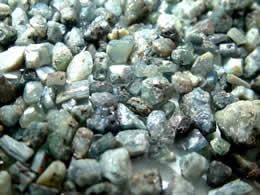Rare Alexandrite Gems
Alexandrite is one of the rarest of all colored gemstones and is famed for its color change from green in daylight to red under incandescent light. Fine faceted alexandrite over 1 carat is more valuable than sapphire, ruby or emerald.
Alexandrite is a strongly pleochroic gem that will exhibit emerald green, red and orange-yellow colors and tend to change color in artificial light compared to daylight. The color change from red to green is due to strong absorption of light in the yellow and blue portions of the spectrum. Typically, alexandrite has an emerald-green color in daylight but exhibits a raspberry-red color in incandescent light.
According to a popular but probably apocryphal story, alexandrite was discovered by the Finnish mineralogist Nils Gustaf Nordenskjold, (1792 -1866) on the tsarevitch Alexander's sixteenth birthday on April 17, 1834 and named alexandrite in honor of the future Tsar Alexander II of Russia. It is apparently true that alexandrite was first identified (but not discovered) by Nordenskjold, but likely some years earlier, around 1831. It was Count Lev Alekseevich Perovskii (1792-1856) who named the gem alexandrite.
Alexandrite is a variety of chrysoberyl, with an excellent hardness of 8.5 on the Mohs scale. Chyrsoberyl has a refractive index of 1.746-1.763 and a density or specific gravity of 3.70-3.78.
Alexandrite is very rare because of its chemical composition. While it is a form of chrysoberyl, it has an extra trace elemement in addition to iron and titatnium. It is the presence of chromium that gives it the emerald-green hue in daylight. Alexandrite exhbiting chatoyancy or the cat's eye effect is known, but very rare.
The original source of alexandrite in the Ural mountains in Russia has been worked out. An important alexandrite deposit was found in 1987 in Minas Gerais in Brazil, and other deposits are found in Burma, Madagascar, Sri Lanka and Tanzania.
Alexandrite is rarely found in larger sizes. The largest cut alexandrite weighs 66 carats and is in the Smithsonian Institution in Washington, D.C.
click here to see the next gemstone
 |
| Alexandrite Rough from Tanzania |
Alexandrite is one of the rarest of all colored gemstones and is famed for its color change from green in daylight to red under incandescent light. Fine faceted alexandrite over 1 carat is more valuable than sapphire, ruby or emerald.
Alexandrite is a strongly pleochroic gem that will exhibit emerald green, red and orange-yellow colors and tend to change color in artificial light compared to daylight. The color change from red to green is due to strong absorption of light in the yellow and blue portions of the spectrum. Typically, alexandrite has an emerald-green color in daylight but exhibits a raspberry-red color in incandescent light.
According to a popular but probably apocryphal story, alexandrite was discovered by the Finnish mineralogist Nils Gustaf Nordenskjold, (1792 -1866) on the tsarevitch Alexander's sixteenth birthday on April 17, 1834 and named alexandrite in honor of the future Tsar Alexander II of Russia. It is apparently true that alexandrite was first identified (but not discovered) by Nordenskjold, but likely some years earlier, around 1831. It was Count Lev Alekseevich Perovskii (1792-1856) who named the gem alexandrite.
 |
| Tsar Alexander the II |
Alexandrite is very rare because of its chemical composition. While it is a form of chrysoberyl, it has an extra trace elemement in addition to iron and titatnium. It is the presence of chromium that gives it the emerald-green hue in daylight. Alexandrite exhbiting chatoyancy or the cat's eye effect is known, but very rare.
The original source of alexandrite in the Ural mountains in Russia has been worked out. An important alexandrite deposit was found in 1987 in Minas Gerais in Brazil, and other deposits are found in Burma, Madagascar, Sri Lanka and Tanzania.
Alexandrite is rarely found in larger sizes. The largest cut alexandrite weighs 66 carats and is in the Smithsonian Institution in Washington, D.C.
click here to see the next gemstone

No comments:
Post a Comment